 |
Vitamins and hormones. Volume 122, Hormones and epigenetics / Series Editor Gerald Litwack, PhD. -- San Diego, CA : Elsevier, 2023. – (58.1743/V837/v.122) |
Contents
Contributors
About the editor
Preface
1. Stem cell development involves divergent thyroid hormone receptor subtype expression and epigenetic modifications in the amphibian intestine during metamorphosis
1. Intestinal stem ceil (ISC)
2. Thyroid hormone receptor (TR)
3. TH response genes
4. TR subtype-dependent and epigenetically regulated ISC development
5. Conclusions and future directions
Acknowledgments
References
2. Epigenetic developmental programming and intergenerational effects of thyroid hormones
1. Introduction
2. Developmental epigenetic programming by thyroid hormones
3. Intergenerational epigenetic effects of thyroid hormones
4. Mechanisms of intergenerational epigenetic effects by THs
5. Thyroid hormones and epigenetic effects of endocrine disruptors
6. Summary
Acknowledgments
References
3. Epigenetic regulation during 1,25-dihydroxyvitamin D3-dependent gene transcription
1. Introduction
2. Mechanisms of epigenetic control in mammals
3. 1,25(OH)2D3-mediated epigenetic control of gene transcription
4. Concluding remarks
Acknowledgments
References
4. Endocannabinoid system and epigenetics in spermatogenesis and testicular cancer
1. Germ cell development and differentiation
2. Origin and classification of TGCTs
3. Epigenetic modifications
4. Epigenetic mechanisms and germ cell development
5. Epigenetic mechanisms and TGCTs
6. Overview of the endocannabinoid system
7. ECS and male germ cell development
8. ECS and TGCTs
9. Crosstalk between ECS and epigenetics
10. Conclusions
Acknowledgments
References
5. The potential role of environmental factors in modulating mitochondrial DNA epigenetic marks
1. Mitochondria and human health
2. Environmental health and the mitochondrial epigenome
3. Future directions and conclusion
References
6. DNA methylation in the pathogenesis of type 2 diabetes
1. Introduction
2. Conclusions
Acknowledgments
References
7. Epigenetics, endometriosis and sex steroid receptors: An update on the epigenetic regulatory mechanisms of estrogen and progesterone receptors in patients with endometriosis
1. introduction
2. Pathogenesis of endometriosis
3. Modifications of steroidogenic transcription factors in endometriosis 174
4. DNA methylation of ERs and PRs in endometriosis
5. Histone modification of ERα in endometriosis
6. Micro RNAs in endometriosis
7. Long non coding RNAs in endometriosis
8. Factors affecting epigenetic changes in endometriosis
9. Conclusion
References
8. Aberrant epigenetic regulation of estrogen and progesterone signaling at the level of endometrial/endometriotic tissue in the pathomechanism of endometriosis
1. Introductory overview
2. Main female sex hormones and epigenetic modifications of EnSCs and/or MSCs in endometriosis
3. Concluding remarks
Acknowledgments
References
9. Early-life AFB1 exposure: DNA methylation and hormone alterations
1. Introduction
2. Early-life exposure to AFB1
3. Conclusion
References
10. Crosstalk between epigenetics and tumor promoting androgen signaling in prostate cancer
1. Introduction
2. Epigenetics
3. Epigenetic alterations in AR signaling
4. Epigenetics in PCa therapy
5. Conclusions
Acknowledgments
Conflict of interest
References
11. Effects of stress and mindfulness on epigenetics
1. Foundations of epigenetics and stress
2. Epigenetics of stress
3. Epigenetics of mindfulness techniques
4. Epigenetic regulation of neurological and mental health biomarkers
5. Epigenetic protection against age-related diseases
6. Future directions
References
Further reading
12. Early life stress, depression and epigenetics
1. Introduction
2. Stress
3. HPA axis
4. inflammation
5. Early life stress
6. Conclusion
References
13. On the road to resilience: Epigenetic effects of meditation
1. Mind, body, and epigenetics
2. Meditation and mindful practices
3. Overview of the main epigenetic mechanisms
4. Stress and disease
5. Stress and meditation
6. Meditation, gene expression and epigenetics
7. Epigenetic clock and meditation
8. Final considerations and future perspectives
Conflict of interest
Acknowledgements
References